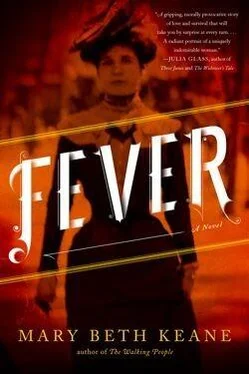“That’s why I’m here, isn’t it? So he can make his name?”
“Mary,” Mr. O’Neill sighed. “Things could be worse for you. You have a private cottage. You have the freedom to move about the island.”
“An island the size of a park. Where everyone I meet shrinks away from me.”
“It could be worse.”
“Well, yes, Mr. O’Neill. You’re absolutely correct. I could be dead, I suppose.”
• • •
Of the many witnesses called the morning of the hearing, a few surprised Mary. Most were people who worked for the Department of Health, or who worked at labs scattered across the city, and who canceled out one another with their opposing views of her case. Half thought that since Mary was a healthy person and had never shown any symptom of the disease she was accused of passing on to so many, the city had no right to imprison her. Others felt just as strongly that it was precisely because Mary showed no symptoms that she must be kept in quarantine for life. “Think of the innocent,” urged a doctor named Stamp whom Mary had never seen before. “No one will think to avoid her in the streets, no one will hesitate from inviting her into his home. Seeing her good health and her experience, what would stop her from being hired to cook in a good house? The Bowen child was only nine years old when she died of Typhoid Fever.”
Mary had hoped that Elizabeth Bowen’s death was one more thing Dr. Soper had made up, wanting to make her situation worse. It had seemed too convenient to their cause. But Mr. O’Neill confirmed it was true, and Mary supposed he had no reason to lie. And now there was an unfamiliar doctor on the stand confirming that truth. Mary remembered the quiet girl who read books and listened to her governess and preferred her bedroom and the parlor to the fresh air outside. Sometimes she came downstairs to see what Mary was making in the kitchen, and a few times Mary had let her dip her finger in a sauce, or take a stewed apple out of a pot with a spoon. One time, Elizabeth asked Mary why she wasn’t married and when Mary told her it was because she didn’t feel like it, Elizabeth said she’d marry Mary in an instant if she’d been a boy.
Then she said, “Is it really because you don’t feel like it? Or is it because you haven’t anyone to marry?”
“Aren’t you bold!” Mary said. “How would you like to pick up someone else’s socks all day long?”
Elizabeth made a face.
“Isn’t it better to earn wages?”
“Yes,” Elizabeth said, entirely convinced.
“And don’t forget,” Mary told her, “if I were a married woman, I probably wouldn’t be here making your supper.”
The first sign that Elizabeth was sick came when she wandered into the kitchen and announced that she was tired. Mary had looked carefully at the girl and thought of Tobias Kirkenbauer.
On the day Mary was taken, the girl had been upstairs, sleeping, her governess watching over her. She’d had the fever, yes, Mary remembered that well. She’d wanted to tell them the best way to help her, the best times to put her in the tub, the coolest cottons to wear next to her skin. She’d sent up a bowl of beef broth to give the girl energy, but they didn’t want to listen to her, and sent the broth back down with Frank. She wanted to see the girl for herself, but once the family called the doctor they closed the girl’s door to all of the staff except for the governess, and when the governess became ill they had the doctor tend to her as well.
One of the reporters had gotten Bette to talk, and Bette told him that Mr. and Mrs. Bowen loved throwing dinner parties more than anything else in the world, and now they were afraid that no one would ever want to come to their home again. According to Bette, Mrs. Bowen vowed that every domestic she hired from now on would be a Swede or a German, because they were more impeccable than every other race. When the reporter asked what Bette thought of Mrs. Bowen’s opinion of Germans and Swedes, Bette agreed that it was probably true. She was fired within an hour of the paper landing on Mr. Bowen’s desk.
Since the Bowens didn’t want to talk, didn’t want to even admit in court that they’d welcomed such a woman into their home, that they’d eaten her filthy food and become sick because of it, Dr. Soper interviewed their friends and neighbors instead, and once one of the reporters caught wind that Soper had been talking to the Bowens’ neighbors, so did that reporter. It was printed in the Evening Sun that the Germ Woman had too many ideas about herself, and because Mrs. Bowen didn’t tolerate her attitude, the Germ Woman infected her on purpose. The stories claimed that Mary was resistant to some of the ways of good Christian households, and purposely defied them by meeting strange men on corners.
Mr. O’Neill made a point of addressing the main rumors that were printed in the 1907 papers, because those would be the details the judges would recall. How can I be resistant to Christianity when I’m a Catholic? Mary demanded of Mr. O’Neill. Tell me that, please. And the man I met once on the corner was a stranger only to them, not to me.
Mary shared with Mr. O’Neill the observation she’d made ages ago, that all the great houses of New York City are the same. They are headed by women who should have been male, and should have been ministers, women who go down to the employment agency in their white gloves to look around like they are in a brothel, discussing terms with the madam while each whore to be hired looks on. Then when the terms are agreed upon, instead of directing the cook to the kitchen or the laundress to the laundry, every lady gives a speech about joining a Christian home.
“The first thing they ask is whether I’m churchgoing. You’d think it would be something to do with cooking, but no, they want to know whether I get myself to a church on Sundays. Do you think the right answer is ‘Yes’?” Mary asked Mr. O’Neill, who listened and waited without showing any indication of what he thought. “Well, it isn’t. Experience taught me that the better answer is ‘No.’ This gives the lady a chance to instruct a new hire on the beneficence of Our Lord. They all say they want a good cook, but what they want even more is a worthy project.”
“What has this to do with anything?” Mr. O’Neill asked. “We were talking about rumors we’ll need to address one by one when we’re in front of the judges.”
“What does it—? It has everything to do with everything we’ve been talking about! Don’t you see? They—”
“Yes?”
Mary thought to tell him again about the hat, but remembered she’d long since given up on making that point. “Look, if you don’t see, you don’t see. I wasn’t a project for them. I refused to be. I was there to cook as well as I could — and I was damn good at it — but at thirty-seven I was past the project stage.” She went along with it in previous employments, but that time, with Mrs. Bowen, a mood took her. The first time Mrs. Bowen brought up Our Lord, Mary laughed, and said He hadn’t made it downtown in years.
“Oh, Mary,” Mrs. Bowen had said.
There was also the imbroglio about the food cooperatives just a few days after confronting Mrs. Bowen with the twin to her own hat. Mrs. Bowen found Mary in the kitchen to tell her that she and a few of the other ladies had decided to organize their cooks into groups on a trial basis. Together, the cooks would learn the new French methods and more exotic cuisines that she and the other ladies would decide on.
“The idea is to be together,” Mrs. Bowen said, “and learn from one another, and it would be a help to you, wouldn’t it, having other cooks to work alongside instead of just being here by yourself?”
Mary went to the church hall on Sixty-Fourth Street to meet the other cooks, and saw that there were only two others. They had the whole place to themselves and their conversation echoed in the vastness of the empty, wood-paneled room; it bounced off the many droplets of glass hanging from the chandelier. The back room of this hall featured a state-of-the-art kitchen that sat empty most nights of the week except for Saturdays, when the church held socials for its parishioners. The kitchen had ceramic double-pot sinks, a zinc-lined icebox, plenty of work space. The three cooks were charged with making a meal for six families. It was to be like that just on Mondays and Tuesdays, for a start. One of the cooks, Clare, seemed to know more than the other two and informed Mary that when they finished up Mary was supposed to deliver a meal to the Compton family on Sixty-First Street on her way back to the Bowens’. They were to follow Clare’s direction because she had more training in the French method than the other two.
Читать дальше












